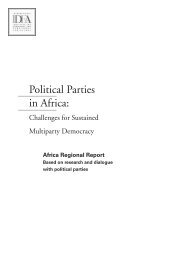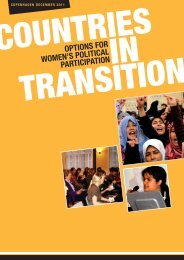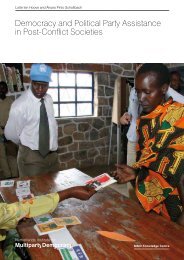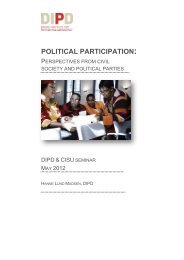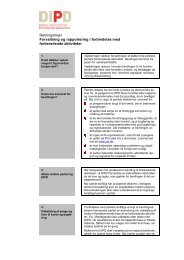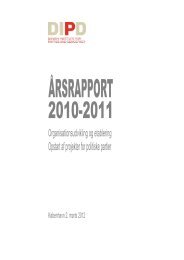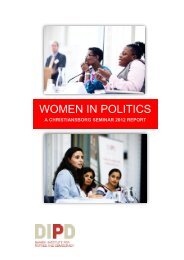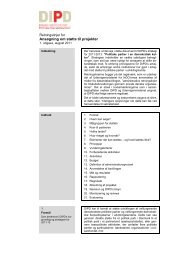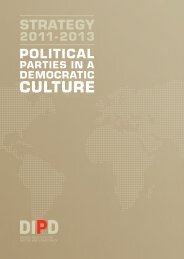Background Document - Danish Institute for Parties and Democracy
Background Document - Danish Institute for Parties and Democracy
Background Document - Danish Institute for Parties and Democracy
You also want an ePaper? Increase the reach of your titles
YUMPU automatically turns print PDFs into web optimized ePapers that Google loves.
In point <strong>for</strong>m, these insights, which seem commonplace today, may be summed<br />
up thus:<br />
´ Formal equality is a necessary, but not a sufficient, prerequisite of true equality.<br />
´ Direct gender discrimination is only the tip of the iceberg, with wide-spread indirect gen-<br />
der discrimination hiding beneath the surface.<br />
´ The private is political.<br />
´ Civilian, political, <strong>and</strong> social rights are based on sexual <strong>and</strong> reproductive rights.<br />
But in 1915, equality be<strong>for</strong>e the law <strong>and</strong> political rights were the undisputed road<br />
to equal status. Though there were discussions in what remained of the women’s<br />
movement of <strong>for</strong>ming a women’s party, <strong>and</strong> though women’s lists were entered in<br />
the first municipal elections, the main tenet throughout the inter-war years was that<br />
women should enrol in, <strong>and</strong> run <strong>for</strong> office via, existing political parties.<br />
However, in the parties the interest in female voters was higher than the interest<br />
in female c<strong>and</strong>idates, <strong>and</strong> more so once the first election results had been reviewed.<br />
Political parties maintained that the state no longer had a part to play given that direct<br />
gender discrimination in legislation had been abolished. From here on out, it was<br />
up to civil society <strong>and</strong> the market to create a fitting gender balance. Until 1945, this<br />
meant one female Member of Parliament per party – the so-called token woman.<br />
The women’s movement thus ended up with the full responsibility <strong>for</strong> increased<br />
political representation of women. To begin with, the movement took up the gauntlet<br />
by launching a nationwide educational programme in citizenship, <strong>and</strong> by facilitating<br />
the founding of women’s organisations within the political parties. Thanks to the<br />
initiative of members active in the women’s cause, all political parties had women’s<br />
committees in the 1930s.<br />
The close collaboration between the women’s movement <strong>and</strong> the political parties<br />
could also be seen in the fact that women’s organisations until the end of the 1970s<br />
drew their chairman from the ranks of prominent female politicians – preferably government<br />
ministers – <strong>and</strong> that the parties took turns holding the post.<br />
Following the Second World War, the women’s movement exp<strong>and</strong>ed its repertoire<br />
to include proper electoral campaigns. In the 1945 elections, the “vote <strong>for</strong> a woman”campaign<br />
was launched. This was to become a fixture of <strong>Danish</strong> electoral campaigns<br />
<strong>for</strong> many years to come. The concept is simple: activists position themselves outside<br />
voting stations carrying posters encouraging voters on their way to the ballot to vote<br />
<strong>for</strong> a woman. This is also when the women’s movement founded the tradition of crossparty<br />
election meetings – a tradition still alive today.<br />
The most spectacular campaign was carried out in the municipal elec-tions of<br />
1970, when the entire female elite in the country was mobilised in a large-scale media<br />
push. The weekend preceding the elections, every nationwide newspaper as well as the<br />
major regional papers carried opinion pieces urging voters to vote <strong>for</strong> a female c<strong>and</strong>idate<br />
<strong>and</strong> written by politicians from all parties, leading members of the women’s organisations,<br />
<strong>and</strong> famous artists. Demonstrating the strength of the feminist heritage,<br />
every single opinion writer drew on the classical arguments of justice, representation,<br />
<strong>and</strong> resources in their plea <strong>for</strong> increased political representation <strong>for</strong> women.<br />
In 1945, the women’s movement also suggested the implementation of a quota<br />
system in the <strong>for</strong>m of a proposal that all parties be m<strong>and</strong>ated to reserve 33 per cent<br />
of the spots on their lists of c<strong>and</strong>idates <strong>for</strong> women. However, this type of affirmative<br />
action did not receive broad support until the third wave of the movement: between<br />
1977 <strong>and</strong> 1996, several parties operated with some <strong>for</strong>m of quota system or other.<br />
By this time the glass ceiling had, however, been broken by the second feminist<br />
wave, which paved the way <strong>for</strong> a new underst<strong>and</strong>ing of the entire concept of politics<br />
WOMEN IN POLITICS DANISH INSTITUTE FOR PARTIES AND DEMOCRACY PAGE 54



